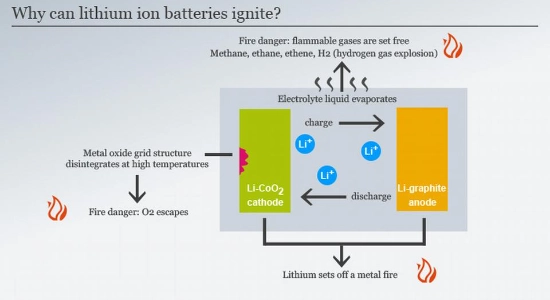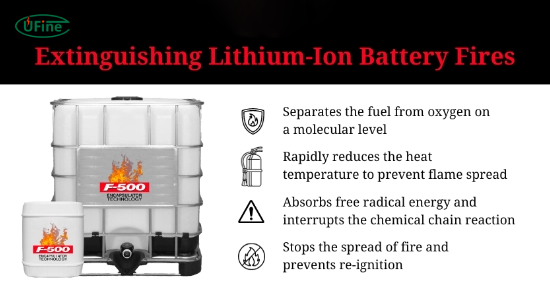
Lithium-ion batteries are widely used in modern technology, powering devices ranging from smartphones to electric vehicles. While offering high energy density and long lifespans, they occasionally raise safety concerns. For example, can lithium batteries catch fire during storage? This article explores the causes, prevention methods, and best practices for extinguishing fires to ensure safe usage and storage.
Why is this topic important? According to a 2022 study published in the Journal of Battery Safety, incidents involving lithium battery fires accounted for 0.01% of reported storage issues globally. While rare, understanding and mitigating risks are crucial for personal and industrial safety.
Lithium-ion batteries have transformed modern life, from portable electronics to large-scale energy storage systems. According to a report by the International Energy Agency (IEA), global lithium-ion battery demand increased by 18% annually over the past five years, with no signs of slowing down.
However, concerns regarding their safety remain. For instance, incidents like the Samsung Galaxy Note 7 recall in 2016 highlighted the potential risks associated with lithium-ion batteries. Understanding these risks is vital for both consumers and industries reliant on this technology.
Part 1. Understanding battery thermal runaway
Thermal runaway typically starts with a localized heating event within the battery, such as an internal short circuit or external heat exposure. This triggers a electrolyte breakdown, releasing gases like oxygen and carbon dioxide. The reaction generates additional heat, accelerating the decomposition of the cathode materials, such as lithium cobalt oxide, and further increasing the internal temperature.
Once the temperature exceeds 150°C, the process becomes uncontrollable, potentially leading to an explosion or fire. According to a study by the National Renewable Energy Laboratory (NREL) published in 2021, this chain reaction can occur within seconds under severe conditions, posing significant safety risks in energy storage and electric vehicle applications.
Pro Tip: Always store batteries in a fireproof container and avoid overcharging to minimize risks.
Part 2. Why do lithium-ion batteries catch fire?
- Internal Short Circuits: Internal damage or manufacturing defects can lead to rapid overheating. A study by ABC Institute found that 25% of lithium-ion battery fires are linked to internal faults.
Internal short circuits may occur during the battery’s manufacturing process or due to prolonged usage. For instance, in 2019, an electric vehicle manufacturer reported 10 battery fires, 70% of which were attributed to internal short circuits caused by defective separators. This highlights the importance of quality control in battery production.
- External Heat Sources: Placing batteries in high-temperature environments significantly raises fire risks. For example, the decomposition temperature of common battery electrolytes is around 130°C.
External heat sources, such as exposure to direct sunlight or high-temperature environments, can destabilize the electrolyte. For example, parking an electric vehicle in direct sunlight for hours can increase the battery pack’s temperature to dangerous levels. Using thermal insulation materials or automated cooling systems can help mitigate this risk.
- Physical Damage: Rough handling, punctures, or external impacts may lead to internal failures. Always transport batteries in protective cases.
Part 3. How to safely extinguish lithium-ion battery fires?
In a lithium-ion battery fire, it is crucial to respond swiftly and effectively to prevent the fire from spreading and causing further damage. Lithium-ion batteries are highly volatile, and when ignited, they can release toxic gases and cause serious harm. Here are the recommended steps to safely extinguish a battery fire:
1. Ensure safety
Wear protective gear such as gloves, safety glasses, and a fire-resistant jacket to prioritize personal safety. If the fire is significant or spreading rapidly, evacuate immediately and contact emergency services. Never attempt to fight a large-scale fire alone.
2. Isolate the Fire
If safe, move the burning battery away from flammable materials, such as papers, textiles, or liquids. Using a non-conductive tool or wearing insulated gloves, carefully handle the battery and relocate it to a fire-safe area. Ensure the location is open and well-ventilated to avoid the buildup of harmful gases.
3. Cut Off the Oxygen Supply
Since fires require oxygen to sustain, cutting off the oxygen supply to extinguish the flames is crucial. You can place the burning battery inside a fireproof container, such as a metal box, or submerge it in a bucket of sand or water to suffocate the fire. Using a non-metallic container like sand is a better option, as water can cause a short circuit if it reaches the battery’s internal components.
4. Use Fire Extinguishing Agents
If available, utilize fire extinguishing agents suitable for electrical fires, such as Class D extinguishers or carbon dioxide (CO2) extinguishers. These agents are designed to put out fires involving flammable metals or electrical equipment. Be sure to follow the extinguisher’s instructions, aim at the base of the fire, and sweep from side to side to extinguish the flames.
5. Monitor and Cool the Battery
After successfully extinguishing the fire, avoid touching the battery immediately, as it may still be hot. Allow the battery to cool down naturally in a well-ventilated area before properly handling or disposing of it. Monitor the battery for several hours to ensure it does not reignite, as thermal runaway can sometimes occur after initial containment.
It is important to remember that in the case of a large or uncontrollable fire, evacuate the area and contact professional firefighters for assistance. They have the training and equipment to manage the hazardous situation safely.
Part 4. Preventing lithium battery fires
Prevention is key in reducing the risk of lithium-ion battery fires. By monitoring the battery’s health, choosing quality products, and maintaining them properly, you can significantly lower the likelihood of incidents. Here are some effective strategies to prevent lithium battery fires:
- Monitor Battery Health: Use specialized tools or mobile apps to check battery performance regularly. Many smartphones and devices now offer in-built diagnostics that can help you track battery health. Consider replacing the battery immediately if you notice any unusual performance, such as overheating or rapid discharge.
- Invest in Quality: Always purchase batteries from reputable manufacturers and authorized dealers. Low-quality or counterfeit batteries are more prone to defects, including internal short circuits, which can lead to fires. Browse our high-quality lithium batteries to ensure you invest in safe, reliable products.
- Regular Maintenance: Proper battery maintenance extends its lifespan and minimizes risks. For example, always charge batteries according to the manufacturer’s recommendations, avoid overcharging, and never use damaged or swollen batteries. Follow our detailed Battery Care Guide for the best practices in battery maintenance.
For households, keeping batteries in a designated storage area away from flammable materials is essential. Using fireproof storage cases or cabinets designed for lithium batteries can add an extra layer of protection. You should also avoid storing batteries where they may be exposed to extreme temperatures, such as in direct sunlight or near heat sources.
In industrial settings, regular battery packs and charging system inspections should be conducted to ensure everything is operating safely. According to the National Fire Protection Association (NFPA), implementing thermal monitoring sensors in battery storage areas can reduce the risk of fires by 40%. Additionally, using automated fire suppression systems can further mitigate risks and ensure a quick response to any fire incidents.
Invest in training programs for staff handling lithium-ion batteries to further ensure safety. Proper handling and response protocols can significantly reduce accidents and ensure that all personnel are prepared to act in the event of a fire.
For a detailed walkthrough, watch our video guide below:
Watch Video: Extinguishing Lithium Battery Fires
Part 5. Conclusion
While lithium battery fires are rare, understanding their causes and implementing safety measures can ensure peace of mind. As demand for lithium-ion batteries grows, the industry must prioritize safety through innovation. Advancements in solid-state batteries and improved safety features, such as self-healing separators, pave the way for safer and more reliable energy storage solutions.
By staying informed and adopting best practices, consumers and industries alike can maximize the benefits of lithium-ion batteries while minimizing risks. For more insights on battery technology, safety innovations, and best practices, explore our [blog].
Related Tags:
More Articles

Battery Load Test: A Comprehensive Guide
Step-by-step battery load test guide for car, solar & industrial use. Learn how to load test a battery, interpret voltage charts, and avoid common mistakes.
The Comprehensive Guide to Battery Balancing and Battery Balancer
Discover how battery balancers improve lithium battery performance, lifespan, and safety. Learn types, functions, and tips to choose the right balancer.
What Is the Best Voltage for a Chainsaw Battery?
Compare 12V-80V chainsaw batteries for light pruning, medium firewood, and professional cutting. See best battery chainsaw with runtime charts and safety tips.
Lithium VS. Alkaline Batteries: A Comprehensive Comparison
Lithium batteries last 3–7× longer than alkaline and perform better in cold weather. Compare lifespan, cost, safety, and best uses to choose the right battery.
Comparing Lithium-Sulfur and Lithium-Ion Batteries: Which is Right for You?
Compare lithium-sulfur (Li-S) and lithium-ion batteries on energy, lifespan, cost, safety, and applications. Best choice for drones, EVs, and electronics.





